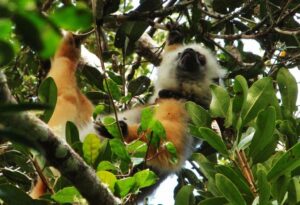
- Profile
- Tour Operators
- Accommodation
- prev
- next
- Get directions
- Call now
- Bookmark
- Share
- Become an influencer
- prev
- next
Overview
The small Analamazaotra Special Reserve (popularly known by the old French name of the nearby town Andasibe and railway station Périnet) is one of the most frequently visited sites in the country, one of the easiest to reach, and one of the best places to observe lemurs in Madagascar, and indeed one of the best primate-watching sites in the world. Almost all visitors to Madagascar will choose to come here to follow the Indri call, which is the undisputable star of the park. An overnight stay at this site is an absolute must for the first time visitor to Madagascar, since it is the single best place in the country for seeing the indri (Indri indri).
Since 2007, Andasibe-Mantadia belongs to UNESCO world nature heritage sites. This forest was protected mainly for the rather large population of Indris living there. Over 60 families reside in the park, and their distinctive ‘howling’ can be heard from up to 3kms away. (The basic function of these displays is to demark territory). They are at their most active at dawn, but during the rest of the day can be seen lazing in the trees all along the majestic trails in Analamazaotra. Indris are the largest living lemurs at all reaching up to 1 meter. It lives in small groups and cannot survive in captivity. Two indri groups in the surrounding forest have been habituated to the presence of tourists and are easily found with the help of our guides.
All exploring is done on foot along trails that weave through the forest: expeditions can vary in length from one hour to five. Walks are particularly rewarding in the early morning when indri calls, sounding rather like a weird forest whalesong, echo through the air. There are different circuits suiting every physical condition and interest.
Analamazaotra consists of mid-altitude montane rain forest at 900–1,250 m, but covers a mere 810 ha. However, it is immediately adjacent to the much larger Mantadia National Park and several other important forests, such as Maromizaha.
In addition to the indri, the following lemurs are also relatively easy to observe at Analamazaotra: Goodman’s mouse lemur (Microcebus lehilahytsara), Crossley’s dwarf lemur (Cheirogaleus crossleyi), weasel sportive lemur (Lepilemur mustelinus), brown lemur (Eulemur fulvus), gray bamboo lemur (Hapalemur griseus griseus), and eastern woolly lemur (Avahi laniger), as well as recently re-introduced diademed sifaka (Propithecus diadema) and sometimes southern black-and-white ruffed lemur (Varecia variegata editorum), also a recent re-introduction. The sifakas are now quite easy to see in the same area as the two habituated indri groups, but the ruffed lemurs are more difficult. There is also a possibility of seeing the red-bellied lemur (Eulemur rubriventer) and the aye-aye (Daubentonia madagascariensis), although sightings of these species are much more infrequent. Finally, the rare hairy-eared dwarf lemur (Allocebus trichotis) is known to occur in the reserve, but is difficult to find. If this species is of interest, be sure to ask for a guide who knows where to look for it. And if you are lucky, you may spy the glamorously named black and white ruffed lemur - an endangered species - rare orchids, super-sized spiders and mesmerizing chameleons.
Near the park entry of Analamazaotra, there’s a small orchid garden including a small lake, which is part of the national park, too.
Location
-
5, Moramanga, Alaotra-Mangoro, Madagascar
Vital Park Information
Madagascar
water is not safe to drink in Madagascar, always drink bottled water or carbonated drinks. When drinking bottled water, check to be sure the seal is not broken on the cap.
Malagasy ariary
April, May, June, July, August, September, October, November
Although the park is accessible all year, hiking conditions are better during the drier season from April until November.




